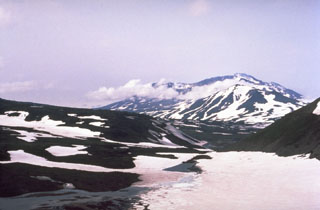Report on Gorely (Russia) — 22 January-28 January 2014
Smithsonian Institution / US Geological Survey
Weekly Volcanic Activity Report, 22 January-28 January 2014
Managing Editor: Sally Sennert.
Please cite this report as:
Global Volcanism Program, 2014. Report on Gorely (Russia) (Sennert, S, ed.). Weekly Volcanic Activity Report, 22 January-28 January 2014. Smithsonian Institution and US Geological Survey.
Gorely
Russia
52.5549°N, 158.0358°E; summit elev. 1799 m
All times are local (unless otherwise noted)
KVERT reported that activity at Gorely decreased significantly in December 2013; volcanic tremor ceased being detected on 12 December, and the temperature of the thermal anomaly decreased during 12-15 December. No thermal anomaly was detected in January 2014, but weak seismicity continued along with gas-and-steam emissions. On 23 January the Aviation Color Code was lowered to Green (on a four-color scale).
Geological Summary. Gorely volcano consists of five small overlapping stratovolcanoes constructed along a WNW-ESE line within a large 9 x 13 km caldera. The caldera formed about 38,000-40,000 years ago accompanied by the eruption of about 100 km3 of tephra. The massive complex includes about 40 cinder cones, some of which contain acid or freshwater crater lakes; three major rift zones cut the complex. Another Holocene stratovolcano is located on the SW flank. Activity during the Holocene was characterized by frequent mild-to-moderate explosive eruptions along with a half dozen episodes of major lava extrusion. Early Holocene explosive activity, along with lava flows filled in much of the caldera. Quiescent periods became longer between 6,000 and 2,000 years ago, after which the activity was mainly explosive. About 600-650 years ago intermittent strong explosions and lava flow effusion accompanied frequent eruptions. Historical eruptions have consisted of moderate Vulcanian and phreatic explosions.

